CAA News Today
CAA’s Committee on Women in the Arts, Archival Recordings from the 1994 Annual Conference
posted by CAA — August 18, 2022
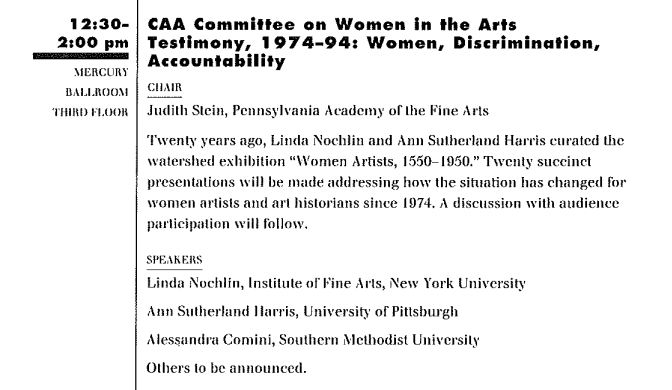
Entry in 1994 Annual Conference program of the Committee on Women in the Arts’ session.
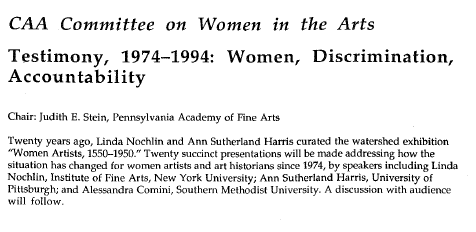
Abstract entry of the Committee on Women in the Arts session in the 1994 Annual Conference abstracts program.
Fifty years ago in 1972, CAA founded its first committees devoted to women in the arts. This year we celebrate the 50th anniversary of this history by sharing historic materials from CAA members and archives that intersect with feminism at the organization, CAA’s Committee on Women in the Arts, and from its Affiliated Societies, the Women’s Caucus for Art (WCA) and The Feminist Art Project (TFAP). CAA established the Committee on the Status of Women (COSW), the first committee to focus on women in CAA’s history, in 1972. The COSW was renamed the Committee on Women in the Arts (CWA) in 1996, and it continues to promote women in the visual arts field.
In 1994, CAA’s Committee on Women in the Arts held a panel chaired by Judith Stein that featured speakers Linda Nochlin, Ann Sutherland Harris, and Alessandra Comini. Their individual presentations look at the progress of women artists and art historians over the previous twenty years, since 1974. The talks use the exhibition, Women Artists 1550-1950, curated by Nochlin and Harris, as a benchmark for discussion. This landmark exhibition toured four American museums in 1976-77, such as the Brooklyn Museum in 1977, and raised public awareness of the many gifted women painters, sculptors, and architects.
The talks in this session compare and contrast the attitudes that prevailed when the show was being organized with views in the nineties. Releasing these recordings of the session almost another twenty years later, it is an opportunity to reassess the status of women in the arts once again.
Biographies of the speakers:
Judith E. Stein chaired CAA’s Committee on Women in the Arts from 1992 to 1997, initiating a series of awards to women in the arts. A writer and curator, Stein studied at Barnard College, and has a Ph.D. in art history from the University of Pennsylvania.
Stein was recently awarded the Lifetime Achievement Award by the Women’s Caucus for Art (WCA) in 2020. She has written at length on feminism and women artists, beginning with her 1981 doctoral thesis on the neoclassic iconography of Sappho, one of the first feminist dissertations in art history at the University of Pennsylvania. She helped organize Philadelphia Focuses on Women in the Visual Arts (FOCUS) in 1973-74 and edited the WCA’s newsletter from 1975 to 1977. She was also a member of the WCA national advisory board from 1979 to 1981. Her first piece of art criticism was published in Art in America in 1974, reviewing a Judy Chicago exhibition. She also wrote on Cecilia Beaux, the first woman to teach at the Pennsylvania Academy of the Fine Arts, Feminist Art Journal, Winter (1975–1976). Her work has also appeared in Art News, The New York Times Book Review, and the National Public Radio’s Fresh Air and Morning Edition.
Stein served on the advisory board of Philadelphia’s Leeway Foundation for women artists, (1994–2002) and was the first curator of Leeway Founder Linda Alter’s collection of art by American women artists. Stein wrote the foundational essay for Making Their Mark: Women Artists Move into the Mainstream, 1970–1985 (Abbeville, 1989) and “Collaboration,” for The Power of Feminist Art (Harry N. Abrams, 1994). She curated The Likeness of Being: Contemporary Self-Portraits by Sixty Women (DC Moore Gallery, New York, 2000), and co-curated Picturing the Modern Amazon: The Hypermuscular Woman (The New Museum of Contemporary Art, New York, 2000).
She is the author of Eye of the Sixties, Richard Bellamy and the Transformation of Modern Art, (Farrar, Straus & Giroux, 2016). Other curatorial projects by Stein include Red Grooms, A Retrospective for the Pennsylvania Academy of the Fine Arts, and I Tell My Heart: The Art of Horace Pippin, which traveled to the Metropolitan Museum of Art in 1995 and earned a best catalogue award from AICA/USA.
Among her honors is a Creative Capital/Andy Warhol Foundation Arts Writers Grant; a Pew Fellowship for literary non-fiction; and a Lannan Foundation writing residency in Marfa, Texas. Learn more about Judith Stein’s career on her webpage and in this WCA announcement.
Alessandra Comini is University Distinguished Professor of Art History Emerita at Southern Methodist University in Dallas, Texas. She received her B. A. degree from Barnard College, her M. A. from the University of California at Berkeley, and her Ph.D. “with distinction” from Columbia University where she taught for ten years. She has also taught at the University of California, Berkeley, Yale University, served as the Alfred Hodder Resident Humanist at Princeton University, and was named Distinguished Visiting Lecturer at Oxford University‘s European Humanities Research Centre (1996). Voted “outstanding professor” by her students sixteen times, she has been extended the Distinguished Teaching Prize of the Meadows School of the Arts and the United Methodist Church Scholar/Teacher of the Year Award (1996).
An undergraduate and a graduate scholarship in Comini’s name have been established by former students, one a professor of surgical oncology in Little Rock, Arkansas; the other, founder and co-owner of an international antiques business in Dallas. The author of major essays and eight books, one of them nominated for the National Book Award (see publications), Dr. Comini was awarded the Grand Decoration of Honor by the Republic of Austria in recognition of her contributions to Germanic culture in 1990. Her lively revisionist work in the history of women artists was acknowledged in 1995 by the Women’s Caucus for Art with the coveted Lifetime Achievement Award. A vibrant lecturer in both English and German, she is in great demand in America and abroad as a speaker in her chosen fields of art and cultural history as well as musical iconography (see lectures)…. (Source: https://www.alessandracomini.com/introduction/)
Ann Sutherland Harris was born in Cambridge, England and was educated in both the USA and the UK (BA 1961 & PhD 1965, University of London at the Courtauld Institute of Art). She has lived in the States since 1965, teaching at Barnard College and Columbia University, and at several other universities before joining the faculty of the University of Pittsburgh as Professor of the History of Art and Architecture in 1984. There she taught a variety of courses to under- graduate and graduate students. She retired from teaching in 2012.
Harris’s research focuses mainly on 17th century Europe, especially painters and sculptors working in Italy and France. She has a particular interest in artists’ drawings and what they reveal about artists’ ideas and intentions, as well as in artists’ self-perceptions and the roles they play as they interact with patrons and their demands. She has published books about Andrea Sacchi and Gian Lorenzo Bernini’s drawings and, most recently, a substantial survey of European 17th century art and architecture (Laurence King, London; 2005; 2nd ed. 2008). A full bibliography of her publications is available on her university’s website.
Harris became interested in the past and present situation of women during the late 1960s and 1970s, when she became an activist for improved status for women in academe. She testified before the US Congress in 1970 about the discrimination faced by women in higher education, and then helped to set up the Women’s Caucus for Art, an advocacy organization for women active as artists, art historians, and museum professionals: she was its first President (1972-74). She also encouraged Wilhelmina Holladay to found a museum devoted to women artists, which she did twenty-five years ago: the National Museum for Women in the Arts in Washington, DC.
Art history and activism came together when Harris and Linda Nochlin co-curated the traveling exhibition Women Artists, 1550-1950 for the Los Angeles County Museum in 1976-7 (also shown at the University Art Museum, Austin, Texas; the Carnegie Museum of Art, Pittsburgh; and the Brooklyn Museum, New York). She was responsible for artists active in the 16th to 18th centuries, and Nochlin for the artists working after 1800, and she contributed most of the catalogue entries for the earlier artists as well as an introduction that provided the essential historical background for the pioneering women artists who emerged in Europe in the mid-sixteenth-century. Since then, she has occasionally written about twentieth-century women, including Alice Neel (1900-84), Elizabeth Murray (1940-2006) and Edna Andrade (1917- 2008), as well as contributing catalogue essays, articles and reviews about Artemisia Gentileschi and Sofonisba Anguissola, and a survey of recent scholarship on Sofonisba, Artemisia, Lavinia Fontana and Elisabetta Sirani for the exhibition, Italian Women Artists from the Renaissance to the Baroque held at the women’s museum in Washington in 2007.
Linda Nochlin was an American feminist art historian most well-known for her 1971 article “Why Have There Been No Great Women Artists?,” which widely influenced art history, leading to new research and awareness of history and how it is written, analyzed, and taught, as well as launching the field of feminist art history.
Nochlin graduated from Vassar College in 1951 with a bachelor’s degree in philosophy and earned a master’s degree in English from Columbia University in 1952. Her doctorate in art history from the Institution of Fine Arts at New York University (NYU) focused on realism and Gustave Courbet. From 1952 to 1979, Nochlin taught art history at Vassar and published two books on 19th-century art in 1966, Realism and Tradition in Art, 1848–1900 and Impressionism and Post-Impressionism, 1874–1904. She shifted her focus to feminism in 1969, when she taught one of Vassar’s first art history courses on women, “The Image of Women in the Nineteenth and Twentieth Centuries.” After her landmark article, in 1976 Nochlin co-curated “Women Artists: 1550–1950” with Anne Sutherland Harris.
Nochlin left Vassar for a professorship at the graduate school at the City University of New York, where she stayed from 1980 until 1990. In the eighties she published more on Courbet, such as Courbet Reconsidered (1988) with Sarah Faunce, which was also an exhibition at the Brooklyn Museum. Nochlin also published Women, Art, and Power, and Other Essays (1988) and The Politics of Vision: Essays on Nineteenth-Century Art and Society (1989). Nochlin than taught at Yale University (1990-1992) and then became a professor at NYU.
During this time, she published Women in the 19th Century: Categories and Contradictions (1997), Representing Women (1999), and Bathers, Bodies, Beauty: The Visceral Eye (2006).
In 1972, CAA founded its first committees devoted to women in the arts. As a part of this yearlong 50th anniversary celebration, we are sharing historic materials from CAA members and archives that intersect with feminism at the organization, including CAA’s Committee on Women in the Arts (CWA) and our Affiliated Societies, Women’s Caucus for Art (WCA) and The Feminist Art Project (TFAP).
This celebration culminates in a program and reception at Boston University’s Joan and Edgar Booth Theatre on Friday, September 23, 2022. This program will reflect upon the incredible history of feminist pioneers at the organization while looking toward a more inclusive, equitable future through the continued work of the CWA. The members of CWA are carrying the torch of feminism during this crucial time of precarity for women’s rights.
Over the next couple months, visit this site (CAA News) and our social media pages to explore more about this history and items from our archives.
CAA’s Committee on Women in the Arts Annual Recognition Award, 2006
posted by CAA — August 18, 2022
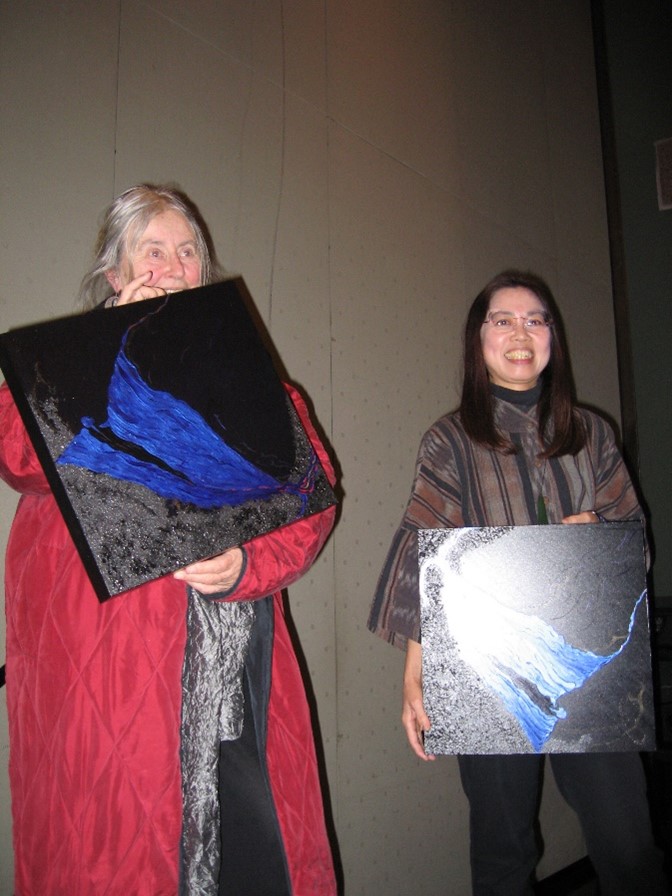
Photo of the 2006 CWA Award recipients, Moira Roth and Trinh T. Minh-ha holding paintings
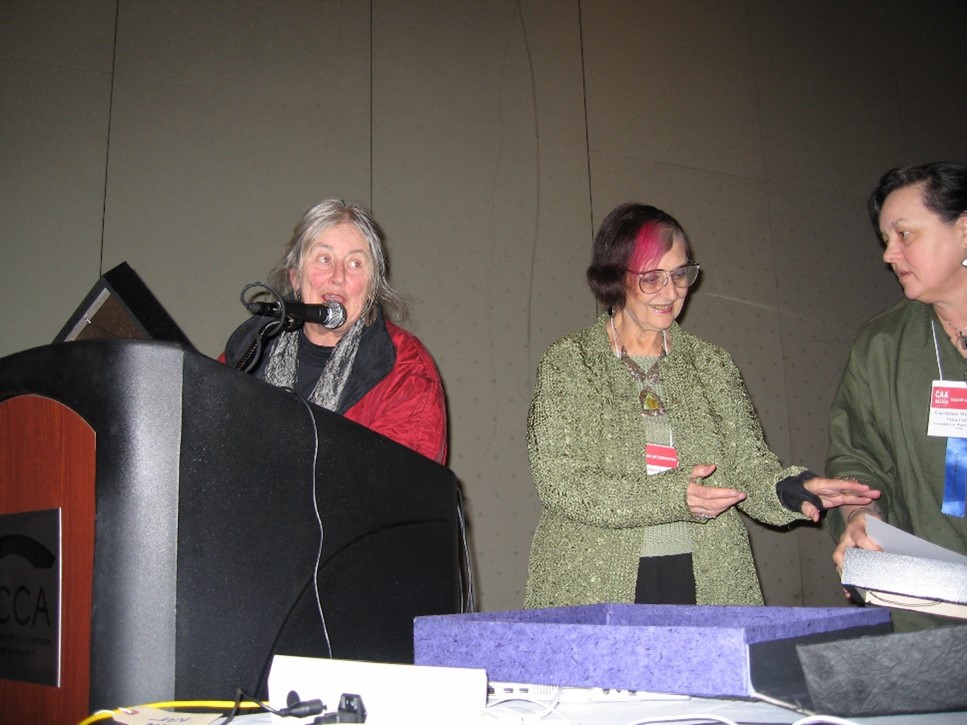
Moira (left) talking at the podium while Eleanor Dickinson (middle), then chair of CWA getting ready with the award gift created by Carolyne Manosevitz
In 2006, during the CAA Annual Conference in Boston, the Committee on Women in the Arts (CWA) honored Moira Roth (Trefethen Professor of Art History at Mills College in Oakland, CA) and Trinh T. Minh-ha (Professor of Women’s Studies and Rhetoric/Film at the University of California at Berkeley) with the CWA Annual Recognition Awards. Then CWA member, Carolyne Manosevitz, offered her own paintings as the award gifts. Roth, who recently passed away, was one of the first scholars to publish on feminist performance art. Her books, The Amazing Decade: Women in Performance Art in America (1983)and Rachel Rosenthal (1995), were groundbreaking. Minh-Ha is a Vietnam-born filmmaker, writer, and composer, whose practice is positioned within the fields of feminist and post-colonial studies.
After 2008, this award became a part of CAA’s Distinguished Awards program as the Distinguished Feminist Awards. The Distinguished Feminist Award is presented annually to a visual artist or designer who, through outstanding efforts in their practice or advocacy, has advanced the cause of equality for women in the arts; as well as a scholar who, through outstanding efforts in their scholarship, curatorial practice, or advocacy, has advanced the cause of equality for women in the arts. Read more about this award and its recipients here.
Post by Midori Yoshimoto
Midori Yoshimoto is associate professor of art history and gallery director at New Jersey City University. Yoshimoto specializes in post-1945 Japanese art and its diaspora with a focus on women artists, Fluxus, and intermedia. Her 2005 book, Into Performance: Japanese Women Artists in New York, led to numerous publications including an essay in Yoko Ono One Woman Show (Museum of Modern Art, New York, 2015). Yoshimoto co-curated a major survey exhibition of Japanese American artist Shigeko Kubota, which traveled three museums in Japan in 2021-22. Its catalog, Viva Video! The Art and Life of Shigeko Kubota was published by Kawade Shobo Shinsha and received the Ringa Art Encouragement Award in Japan. She is also a co-editor and author of a recent publication, Women, Aging, and Art: A Crosscultural Anthology (Bloomsbury, 2021).
In 1972, CAA founded its first committees devoted to women in the arts. As a part of this yearlong 50th anniversary celebration, we are sharing historic materials from CAA members and archives that intersect with feminism at the organization, including CAA’s Committee on Women in the Arts (CWA) and our Affiliated Societies, Women’s Caucus for Art (WCA) and The Feminist Art Project (TFAP).
This celebration culminates in a program and reception at Boston University’s Joan and Edgar Booth Theatre on Friday, September 23, 2022. This program will reflect upon the incredible history of feminist pioneers at the organization while looking toward a more inclusive, equitable future through the continued work of the CWA. The members of CWA are carrying the torch of feminism during this crucial time of precarity for women’s rights.
Over the next couple months, visit this site (CAA News) and our social media pages to explore more about this history and items from our archives.
Countering Feminist Indifference: Notes from the Women’s Caucus for Art
posted by CAA — August 15, 2022
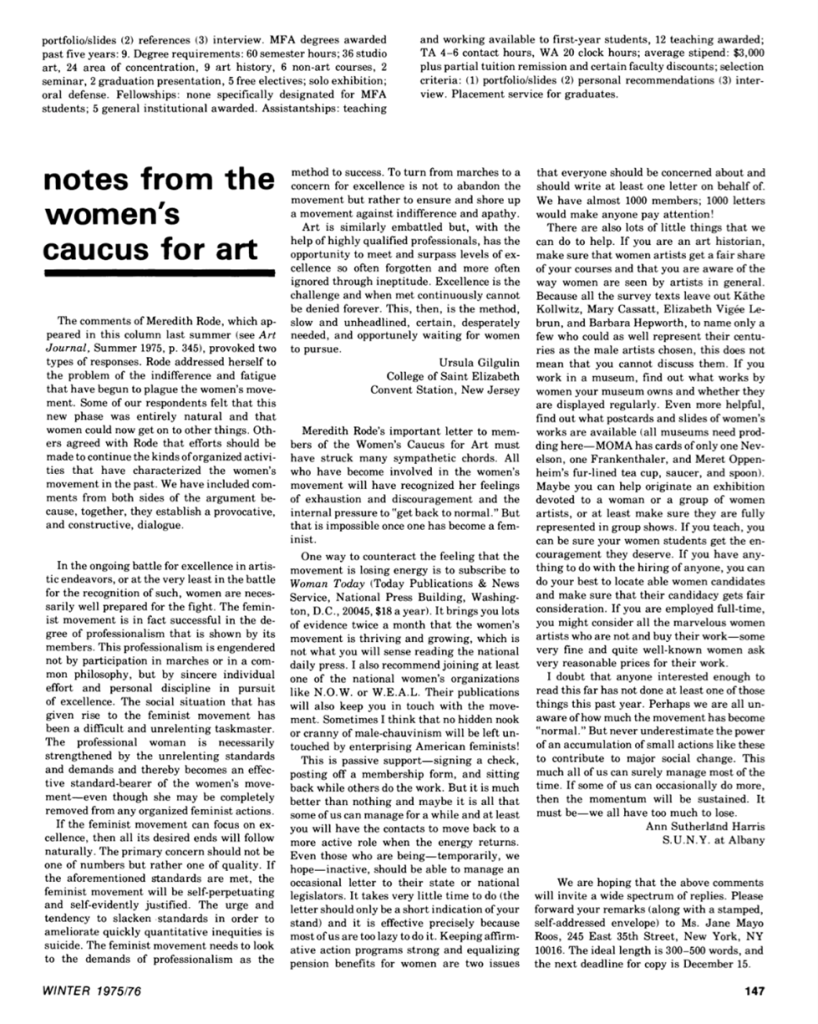
See full text reproduced below. Article also available on Jstor.
“Notes from the Women’s Caucus for Art (WCA),” a column featured in Art Journal during the 1970s, created an important forum for critical debates in the feminist art movement. In Summer 1975, for example, Meredith Rode shared evidence of fatigue with the feminist struggle in her letter “The High Price of Indifference.” Rode’s letter generated numerous responses in the winter 1975 issue, including Ann Sutherland Harris’s practical advice on how to counter this exhaustion.
The first President of WCA advocated both passive and activist gestures, ranging from sending a check to the National Organization of Women to pressuring local museums to display works by women in their collections, organizing group shows of women artists, mentoring female students, and buying women’s art.
This snapshot of WCA’s essential role in feminism art and activism reminds us how we can individually act to demand equity while working in conjunction with the collective efforts of essential national organizations, such as WCA and CAA. Read the full text below.
Post by Joanna Gardner-Huggett
Sources:
- Meredith Rode, “Notes from the Women’s Caucus for Art: The High Price of Indifference,” Art Journal (Summer 1975): 345.
- Ann Sutherland Harris, “Notes from the Women’s Caucus for Art,” Art Journal (Winter 1975/76): 147.
Biography of post author: Joanna Gardner-Huggett is an Associate Professor of History of Art and Architecture at DePaul University and Chair of the Committee on Women in the Arts. She teaches courses on twentieth-century art and feminist theory, while her research focuses on the intersection between feminist collaboration and arts activism and has been published in numerous journals and anthologies. Joanna’s most recent scholarship explores the history of the Chicago based women artists’ collectives Artemisia Gallery in Chicago (1973-2003), ARC Gallery (1973-present), and Sapphire and Crystals (1987-present).
FULL TEXT (from image): Ann Sutherland Harris, “Notes from the Women’s Caucus for Art,” Art Journal (Winter 1975/76): 147.
The comments of Meredith Rode, which appeared in this column last summer (see Art Journal, Summer 1975, p. 345), provoked two types of responses. Rode addressed herself to the problem of the indifference and fatigue that have begun to plague the women’s movement. Some of our respondents felt that this new phase was entirely natural and that women could now get on to other things. Other agreed with Rode that efforts should be made to continue the kinds of organized activities that have characterized the women’s movement in the past. We have included comments from both sides of the argument because, together, they establish a provocative, and constructive, dialogue.
In the going battle for excellence in artistic endeavors, or at the very least in the battle for the recognition of such, women are necessarily well prepared for the fight. The feminist movement is in fact successful in the degree of professionalism that is shown by its members. This professionalism is engendered not by participation in marches or in a common philosophy, but by sincere individual effort and personal discipline in pursuit of excellence. The social situation that has given rise to the feminist movement has been a difficult and unrelenting taskmaster. The professional woman is necessarily strengthened by the unrelenting standards and demands and thereby becomes an effective standard-bearer of the women’s movement—even though she may be completely remove from any organized feminist actions.
If the feminist movement can focus on excellence, then all its desire ends will follow naturally. The primary concern should not be one of the numbers but rather one of quality. If the aforementioned standards are met, the feminist movement will be self-perpetuating and self-evidently justified. The urge and tendency to slacken standards in order to ameliorate quickly quantitative inequities is suicide. The feminist movement needs to look to the demands of professionalism as the method to success. To turn from marches to a concern for excellence is not to abandon the movement but rather to ensure and shore up a movement against indifference and apathy.
Art is similarly embattled but, with the help of highly qualified professionals, has the opportunity to meet and surpass levels of excellence so often forgotten and more often ignored through ineptitude. Excellence is the challenge and when met continuously cannot be denied forever. This, then, is the method, slow and unheadlined, certain, desperately needed, and opportunely waiting for women to pursue.
Ursela Gilgulin, College of Saint Elizabeth, Convent Station, New Jersey
Meredith Rode’s important letter to members of the Women’s Caucus for Art must have struck many sympathetic chords. All who have become involved in the women’s movement will have recognized her feelings of exhaustion and discouragement and the internal pressure to “get back to normal.” But that is impossible once one has become a feminist.
One way to counteract the feeling that the movement is losing energy is to subscribe to Women Today. It brings you lots of evidence twice a month that the women’s movement is thriving and growing, which is not what you will sense reading the national daily press. I also recommend joining at least one of the national women’s organizations like N.O.W. or W.E.A.L. Their publications will also keep you in touch with the movement. Sometimes I think that no hidden nook or cranny of male-chauvinism will be left untouched by enterprising American feminists!
This is pass support—signing a check, posting off a membership form, and sitting back while others do the work. But it is much better than nothing and maybe it is all that some of us can manage for a while and at least you will have the contacts to move back to a more active role when the energy returns. Even those who are being—temporarily, we hope—in active, should be able to manage an occasional letter to their state or national legislators. It takes very little time to do (the letter should only be a short indication of your stand) and it is effective precisely because most of us are too lazy to do it. Keeping affirmative action programs strong and equalizing pension benefits for women are two issues that everyone should be concerned about and should write at least one letter on behalf of. We have almost 1000 members; 1000 letters would make anyone pay attention!
There are also lots of little things that we can do to help. If you are an art historian, make sure that women artists get a fair share of your courses and that you are aware of the way women are seen by artists in general. Because all the survey texts leave out Käthe Kollwitz, Mary Cassatt, Élisabeth Louise Vigée Le Brun, and Barbara Hepworth, to name only a few who could as well represent their centuries as the male artists chosen, this does not mean that you cannot discuss them. If you work in a museum, find out what works by women your museum owns and whether they are displayed regularly. Even more helpful, find out what postcards and slides of women’s works are available (all museums need prodding here—MOMA has cards of only one Nevelson, one Frankenthaler, and Meret Oppenheim’s fur-lined tea cup, saucer, and spoon). Maybe you can help originate an exhibition devoted to a woman or a group of women artists, or at least make sure they are fully represented in group shows. If you teach, you can be sure your women students get the encouragement they deserve. If you have anything to do with the hiring of anyone, you can do your best to locate able women candidates and makes sure that their candidacy gets fair consideration. If you are employed full-time, you might consider all the marvelous women artists who are not and buy their work—some very fine and quite well-known women ask very reasonable prices for their work.
I doubt that anyone interested enough to read this far has not done at least one of these things this past year. Perhaps we are all unaware of how much the movement has become “normal.” But never underestimate the power of an accumulation of small actions like these to contribute to major social change. This much all of us can surely manage most of the time. If some of us can occasionally do more, then the momentum will be sustained. It must be—we all have too much to lose.
Ann Sutherland Harris, S.U.N.Y at Albany
In 1972, CAA founded its first committees devoted to women in the arts. As a part of this yearlong 50th anniversary celebration, we are sharing historic materials from CAA members and archives that intersect with feminism at the organization, including CAA’s Committee on Women in the Arts (CWA) and our Affiliated Societies, Women’s Caucus for Art (WCA) and The Feminist Art Project (TFAP).
This celebration culminates in a program and reception at Boston University’s Joan and Edgar Booth Theatre on Friday, September 23, 2022. This program will reflect upon the incredible history of feminist pioneers at the organization while looking toward a more inclusive, equitable future through the continued work of the CWA. The members of CWA are carrying the torch of feminism during this crucial time of precarity for women’s rights.
Over the next couple months, visit this site (CAA News) and our social media pages to explore more about this history and items from our archives.
The Women’s Caucus of Art’s 1994 Honors Awards Exhibition at the Queens Museum
posted by CAA — August 08, 2022
The Women’s Caucus of Art (WCA) began at CAA in 1972 and broke off to become an independent organization in 1974. Their mission is to create community through art, education, and social activism. recognizing the contribution of women in the arts; providing women with leadership opportunities and professional development; expanding networking and exhibition opportunities for women; supporting local, national and global art activism; and advocating for equity in the arts for all. The organization is still active with many local branches and as an Affiliated Society of CAA holds an annual meeting held in conjunction with CAA. It has awarded prizes for lifetime achievement to many of the (now) best-known American women artists, beginning in 1978 with Isabel Bishop, Louise Nevelson, Georgia O’Keeffe, Selma Burke, and Alice Neel.
Each year since 1979, the WCA presented an exhibition of honorees’ work in conjunction with their national conference. In 1994, the exhibition took place at the Queens Museum of Art, showing work by Mary Adams, Maria Enriques de Allen, Beverly Pepper, Faith Ringgold, Rachel Rosenthal, and Charlotte Streifer Rubinstein. Ringgold and Rubinstein were active WCA members at the time.
Explore the exhibition through archival photographs below!
All images courtesy of the Queens Museum, New York.
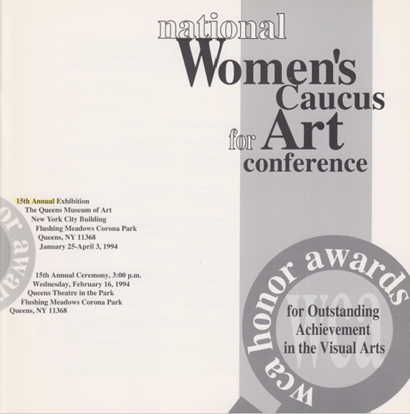
Cover of the WCA catalog for the 1994 exhibit at the Queens Museum of Art. See more WCA exhibition catalogs on their website.
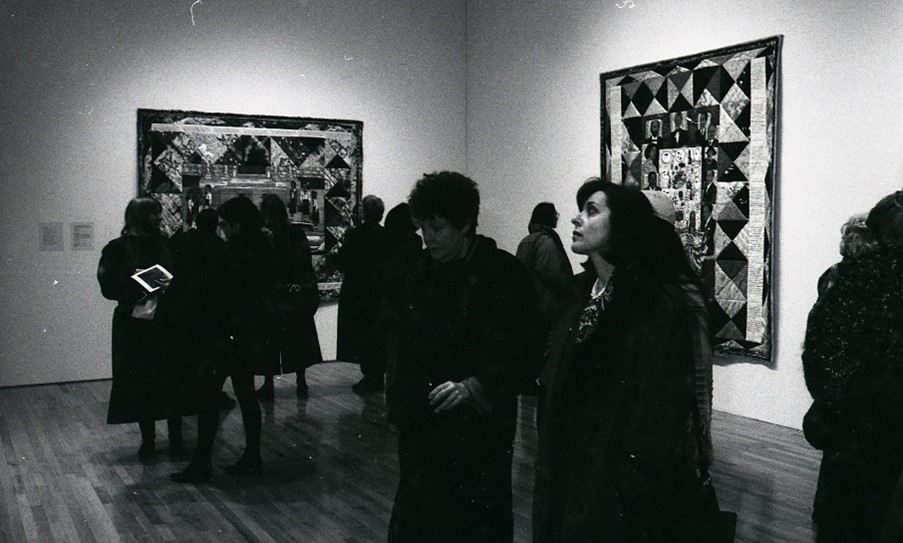 Opening of WCA’s 1994 exhibition at the Queens Museum of Art. Quilt works by honoree, Faith Ringgold.
Opening of WCA’s 1994 exhibition at the Queens Museum of Art. Quilt works by honoree, Faith Ringgold.
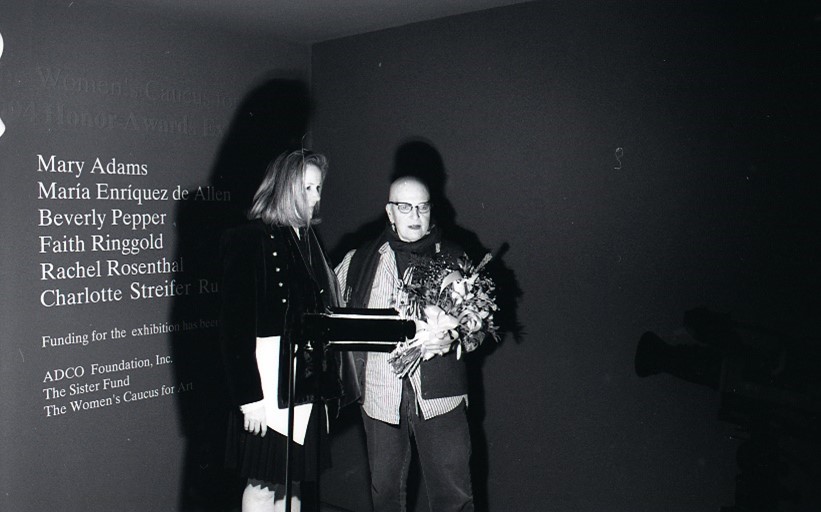
Opening of WCA’s 1994 exhibition at the Queens Museum of Art. Rachel Rosenthal (right) was the first performance artist ever to be a WCA Honoree.
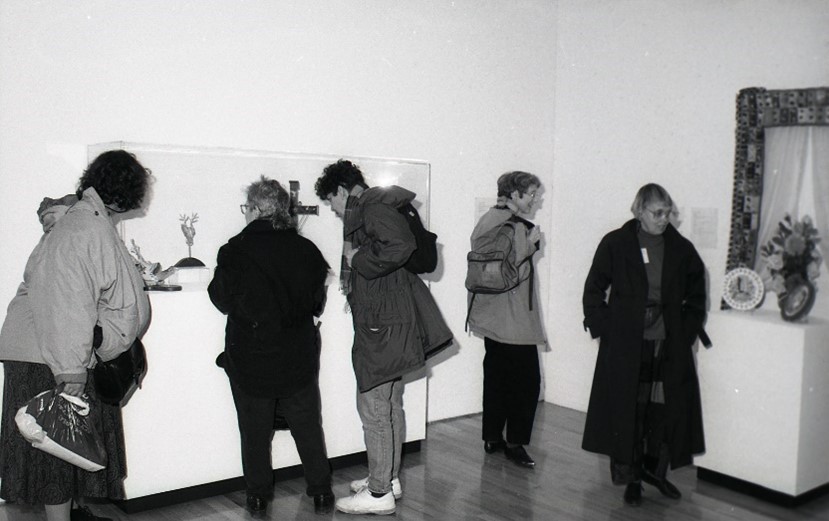
Opening of WCA’s 1994 exhibition at the Queens Museum of Art.
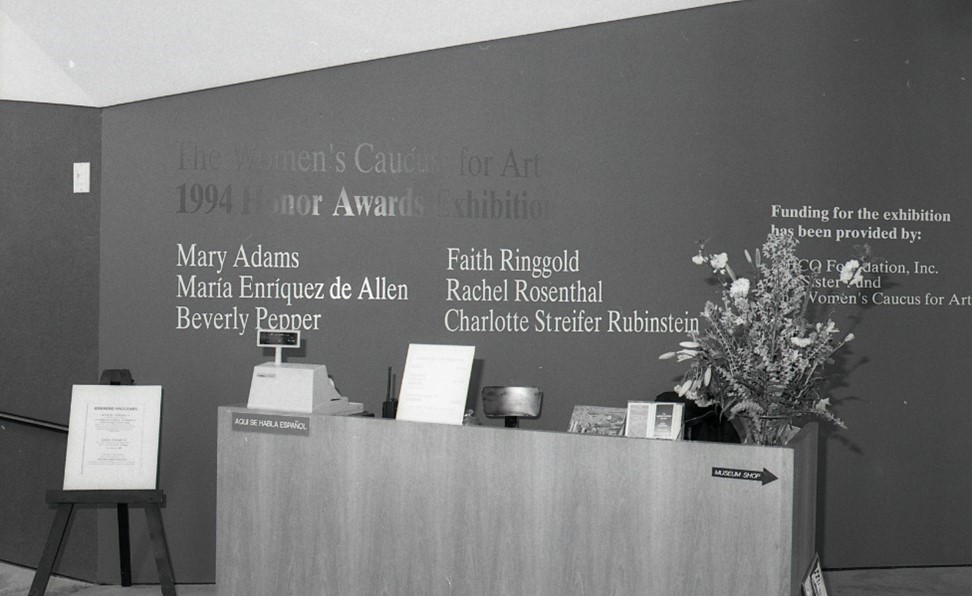 Opening of WCA’s 1994 exhibition at the Queens Museum of Art.
Opening of WCA’s 1994 exhibition at the Queens Museum of Art.
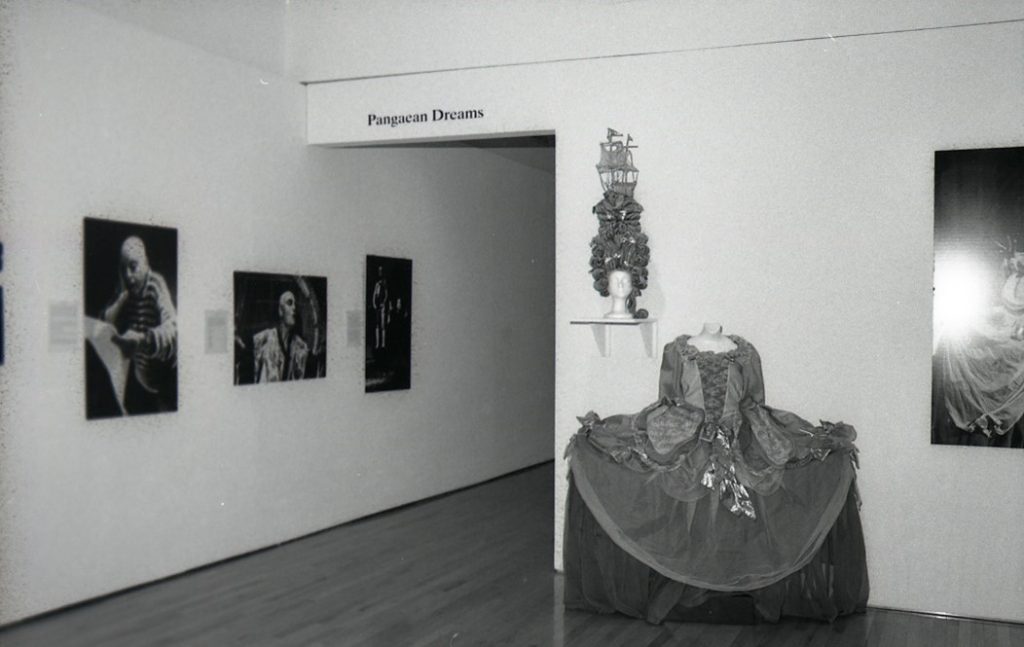 Opening of WCA’s 1994 exhibition at the Queens Museum of Art.
Opening of WCA’s 1994 exhibition at the Queens Museum of Art.
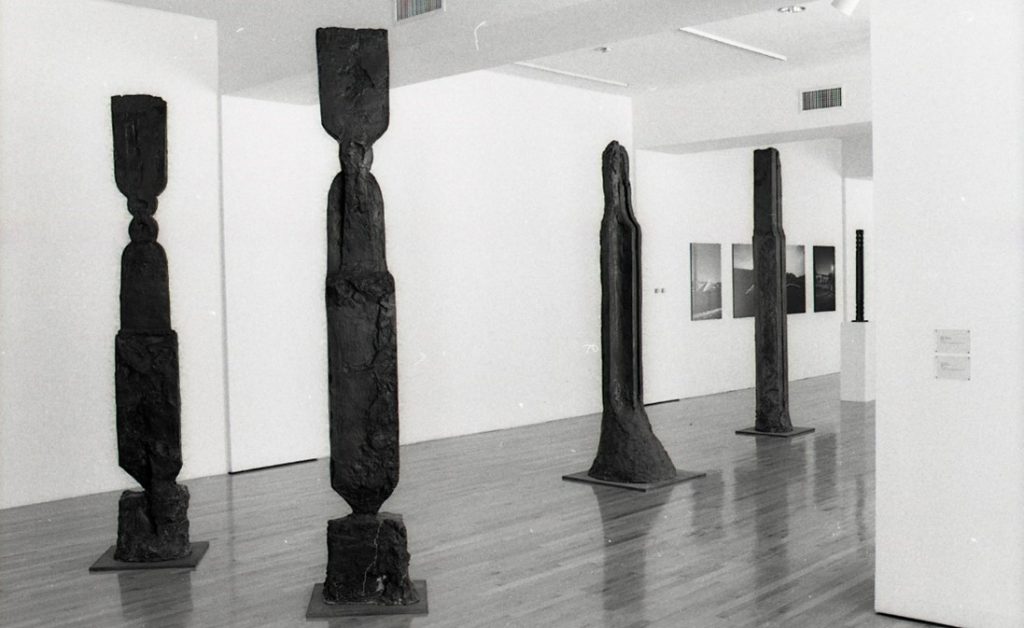 Opening of WCA’s 1994 exhibition at the Queens Museum of Art. Award recipient, Beverly Pepper’s work, The Todi Columns, 1979.
Opening of WCA’s 1994 exhibition at the Queens Museum of Art. Award recipient, Beverly Pepper’s work, The Todi Columns, 1979.
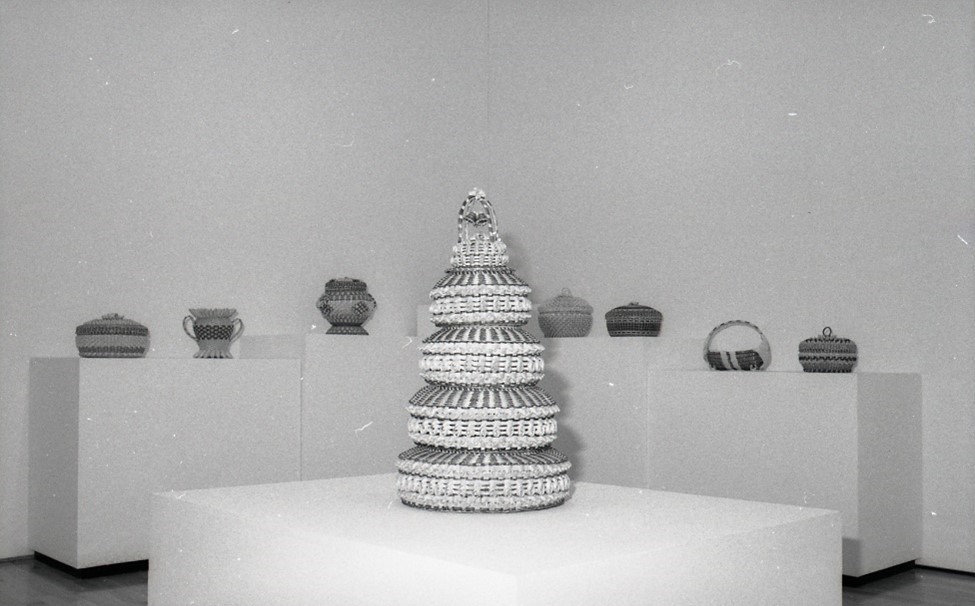 Opening of WCA’s 1994 exhibition at the Queens Museum of Art. Award recipient Mary Adams’s work, Wedding Cake Basket. Adams was the first Native American Honoree from the Mohawk Nation and had started making baskets when she was ten years old.
Opening of WCA’s 1994 exhibition at the Queens Museum of Art. Award recipient Mary Adams’s work, Wedding Cake Basket. Adams was the first Native American Honoree from the Mohawk Nation and had started making baskets when she was ten years old.
In 1972, CAA founded its first committees devoted to women in the arts. As a part of this yearlong 50th anniversary celebration, we are sharing historic materials from CAA members and archives that intersect with feminism at the organization, including CAA’s Committee on Women in the Arts (CWA) and our Affiliated Societies, Women’s Caucus for Art (WCA) and The Feminist Art Project (TFAP).
This celebration culminates in a program and reception at Boston University’s Joan and Edgar Booth Theatre on Friday, September 23, 2022. This program will reflect upon the incredible history of feminist pioneers at the organization while looking toward a more inclusive, equitable future through the continued work of the CWA. The members of CWA are carrying the torch of feminism during this crucial time of precarity for women’s rights.
Over the next couple months, visit this site (CAA News) and our social media pages to explore more about this history and items from our archives.
History of CAA’s Committee on Women in the Arts (CWA)
posted by CAA — July 29, 2022
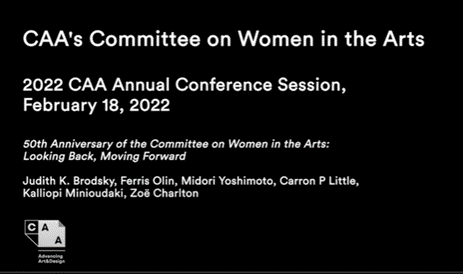
At CAA’s 2022 Annual Conference, current and former members of the Committee on Women in the Arts (CWA) presented a session on the history of feminism at CAA and within their committee entitled “50 Years of Feminist Art at CAA: Looking Back, Looking Forward.” Watch the video below to hear a series of talks on this history.
50 Years of Feminist Art at CAA: Speakers
Chair: Joanna P. Gardner-Huggett, DePaul University
Judith K. Brodsky, Pennsylvania Academy of Fine Arts
Ferris Olin, Rutgers University
Midori Yoshimoto, New Jersey City University
Carron P. Little, School of the Art Institute of Chicago
Kalliopi Minioudaki, Independent Scholar and Curator
Zoë Charlton, American University
Abstract: Fifty years ago, the Committee on Women in the Arts was founded to promote the recognition of women’s valuable contribution to the visual arts and to critical art-historical study; advocate for feminist scholarship and activism in art; develop partnerships with organizations with compatible missions; monitor the status of women in the visual-arts professions; provide historical and current resources on feminist issues; and support emerging artists and scholars in their careers. In 2020, the CWA implemented the 50/50 initiative, which aims for 50% representation of women scholars and artists at the CAA Annual Conference and intersectional feminist content inclusive of race, class, gender, body size, disability, or age. At this significant juncture, this session proposes to reflect on the committee’s history by inviting previous members and chairs to discuss their work with the CWA, as well as collaborations with other affiliate committees and groups, such as the Women’s Caucus for Art, The Feminist Art Project, the Queer Caucus, and many more. In addition to assessing CWA’s past contributions, the panel will engage in a conversation of what work remains to be done.
In 1972, CAA founded its first committees devoted to women in the arts. As a part of this yearlong 50th anniversary celebration, we are sharing historic materials from CAA members and archives that intersect with feminism at the organization, including CAA’s Committee on Women in the Arts (CWA) and our Affiliated Societies, Women’s Caucus for Art (WCA) and The Feminist Art Project (TFAP).
This celebration culminates in a program and reception at Boston University’s Joan and Edgar Booth Theatre on Friday, September 23, 2022. This program will reflect upon the incredible history of feminist pioneers at the organization while looking toward a more inclusive, equitable future through the continued work of the CWA. The members of CWA are carrying the torch of feminism during this crucial time of precarity for women’s rights.
Over the next couple months, visit this site (CAA News) and our social media pages to explore more about this history and items from our archives.
CAA’s 50th Anniversary Celebration of Feminism + Art
posted by CAA — July 29, 2022
In 1972, CAA founded its first committees devoted to women in the arts. As a part of this yearlong 50th anniversary celebration, we are sharing historic materials from CAA members and archives that intersect with feminism at the organization, including CAA’s Committee on Women in the Arts (CWA) and our Affiliated Societies, Women’s Caucus for Art (WCA) and The Feminist Art Project (TFAP).
This celebration culminates in a program and reception at Boston University’s Joan and Edgar Booth Theatre on Friday, September 23, 2022. This program will reflect upon the incredible history of feminist pioneers at the organization while looking toward a more inclusive, equitable future through the continued work of the CWA. The members of CWA are carrying the torch of feminism during this crucial time of precarity for women’s rights.
Over the next couple months, visit this site (CAA News) and our social media pages to explore more about this history and items from our archives.
CWA Picks: Summer 2022
posted by CAA — June 30, 2022
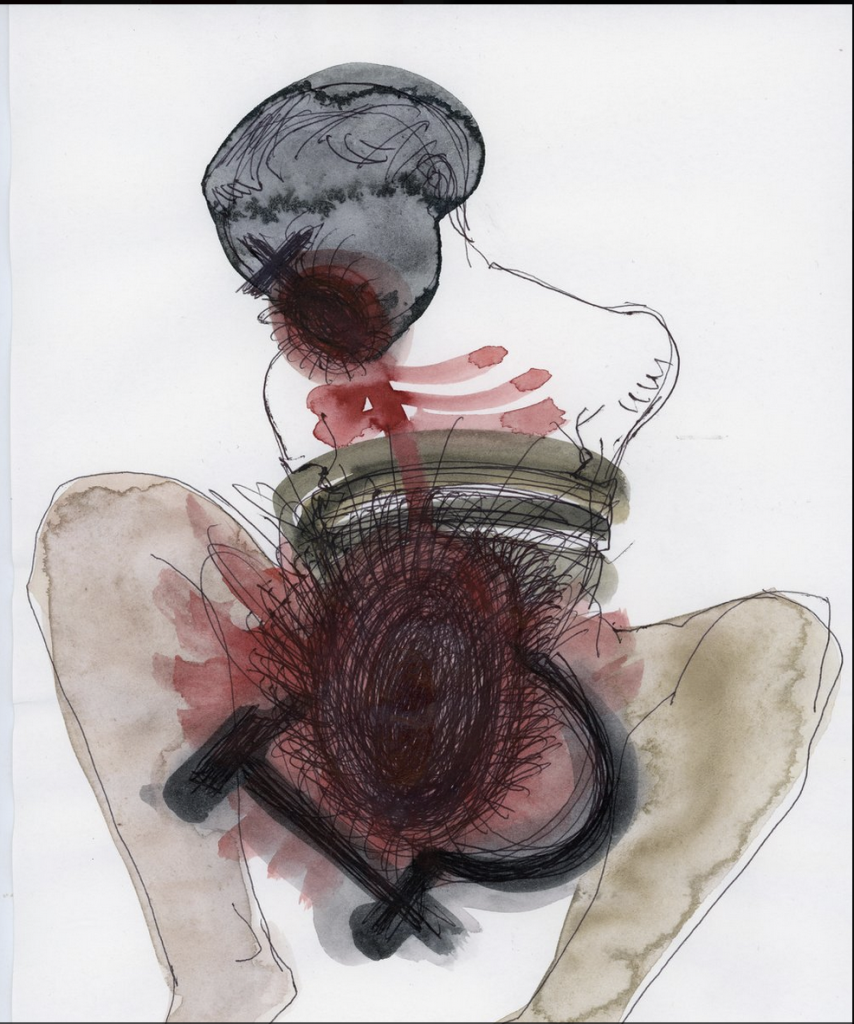
Vlada Ralko, Lviv Diary No. 020, 2022, ink and watercolor on paper, 11.5 x 8.5 inches, ©Vlada Ralko, courtesy of Voloshyn Gallery and Fridman Gallery
Exhibitions and Scholarship Selected by the Committee on Women in the Arts (CWA)
If trauma names the psychic impact of damaging events, it also points to the possibility of working through the mute immobility that is trauma’s primary effect. Gender hierarchies are part of trauma and the recovery from it. In What Does a Woman Want? Reading and Sexual Difference (1993), Shoshana Felman makes a broad and provocative claim: “every woman’s life contains explicitly or in implicit ways, the story of trauma.” The scholarship and exhibitions featured here substantiate Felman’s insight. In a few exhibitions, trauma is pronounced and linked to specific events, such as Russia’s assault on Ukraine. In others, trauma must be discerned in portrayals that attest to the diffuse reality of gender inequity. All of the work tells us that the current historical moment is rife with danger and violence and thereby underscores the necessity of feminism’s insights.
Each month, CAA’s Committee on Women in the Arts selects the best in feminist art and scholarship. The following exhibitions and events should not be missed.
Trauma-Informed Pedagogy: Addressing Gender-Based Violence in the Classroom
Jocelyn E. Marshall and Candace Skibba (eds.)
Emerald Publishing, 2022
What role can teaching play in the effort to address gender-based violence? This collection offers practical, creative, and theoretical strategies for addressing this specific form of trauma in the classroom. The editors assert that teaching can create spaces that counter the “silence” and “unempathetic discourse” that gender-based violence most often meets when it is brought into the open. Featuring the artwork of and scholarship on the indigenous artist Julia Rose Sutherland, as well as a conversation between curators Monika Fabijanska and Dineke Van der Walt, Trauma-Informed Pedagogy foregrounds visual art practices as tools for exploring trauma and finding possibilities for recovery. This makes perfect sense, given the “troublesome visual representations” that block out the fact that gender-based violence is pervasive but systematically denied, a trauma in and of itself.
Women Painting Women
Museum of Modern Art, Fort Worth, Texas
Through September 25, 2022
Feminist art tends to be associated with practices that defy medium, genre, and the art historical canon, but what about the women painters who situate their work firmly in the figurative tradition? Curated by Andrea Karnes, Women Painting Women features the work of forty-six painters who have made women their subjects since the 1960s and illuminates the feminism that can animate figuration. Creatively rendering women’s “bodies, gestures, and individuality,” together these portraits play with a range of scales that move from the modest (Somaya Critchlow) to the gigantic (Jenny Saville) and suggest the spaces allotted to women and the spaces they want to claim. Women Painting Women is a refreshingly straightforward but decidedly necessary theme, given how rare it is to see women as artists and artistic subjects at the same time.
Martine Syms, Neural Swamp
Philadelphia Museum of Art
Through October 30, 2022
Martine Syms’ multi-channel video installation Neural Swamp deploys the tactics of surveillance, cinema, and sport to investigate what it means to be a Black woman in a hyper-digitized world. Blurring the line between horror and humor, Syms works with algorithms and artificial intelligence to question the technologies that erase and exploit Black bodies, voices, and narratives. Accompanied by Kit’s World, a series of videos that also explore technological mediation, Neural Swamp was commissioned by the Future Fields commission in Time-Based Media.
Women at War
Fridman Gallery, New York
July 6 through August 26, 2022
In collaboration with Voloshyn Gallery in Kyiv, Ukraine, Monika Fabijanska curated this timely exhibition that documents how Ukrainian women artists explore the gendered dimensions and consequences of war. Several artworks were made after Russia’s invasion of Ukraine in February 2022, others date from the eight years of war following the annexation of Crimea and the creation of separate ‘republics’ in Donbas in 2014. Together the artwork in Women at War poses questions about women as the natural victims of war and creates a nuanced picture, both of Ukrainian feminism, and the visual practices that have accompanied it. Through a wide array of themes, mediums, styles, Women at War narrates a nuanced history of women in Ukraine and is, more broadly, a historiographic project that meditates on how women become visible when history is written as a war against their agency.
Cornelia Parker
Tate Britain, London
Through October 16, 2022
One of Britain’s most beloved contemporary artists, Cornelia Parker works with domestic objects and reconfigures their scale through playful visual storytelling that often defies gravity. By doing so, Parker’s sculptures materialize the violence that undergirds everyday life and suspends it in the field of vision for all to see.
Ancestors Know Who We Are
Online
National Museum of the American Indian
The Smithsonian, Washington D.C.
Ancestors Know Who We Are is the Smithsonian’s first exhibition to feature Black-indigenous women artists. The title is borrowed from Storm Webber’s 2016 letterpress print, a statement she crafted in black sans serif letters in response to comments that she is neither Black nor Native enough. Across a range of mediums that trouble distinctions between tradition and the contemporary , the artists in this exhibition challenge assumptions that Native and Black experiences have essential and easily discernible features. In so doing, they unsettle the visual economy of race and the permission it gives to question who people are.
Andrea Bowers
Hammer Museum, University of California, Los Angeles
Through September 4, 2022
This is Andrea Bowers’ first museum retrospective and it surveys two decades of her artwork’s intimate connection to activism. A large part of Bowers’ work reframes protest banners and posters to show that political address is a form of creative expression that seeks to imagine and write more just worlds. Isolation and despair haunt this artwork, but the austerity Bowers brings to her images of protest ultimately draws attention to the bravery of individual activists as they seek collectivities that can confront and transform the regressive politics of twenty-first century mobs.
Yayoi Kusama, A Poem in My Heart
Yayoi Kusama Museum
Tokyo, Japan
Through August 28, 2022
This exhibition highlights the Surrealism that pulsates through Yayoi Kusama’s hallucinatory visions. Featuring paintings from the 1950s, viewers can see further into the artist’s inner landscapes and psychic worlds. The artwork overflows with organic, idiosyncratic forms that twist and undulate to reveal the poetics of Kusama’s creative heart.
Suzanne Lacy, The Medium is Not the Only Message
Queens Museum
Queens, New York
Through August 14, 2022
The Medium is Not the Only Message is a major survey of an artist who helped define feminist performance in the 1970s. Lacy has consistently put social issues—sex work, violence against women, racism, labor rights, poverty, and aging—at the center of her work. In recent years, she has become an artist who expands the reach of the museum, bringing institutions into the public worlds in which they are situated. This exhibition focuses on two dimensions of Lacy’s practice: personal narrative and conversation. Both underscore the value she places on relationality, co-creation, and mutual learning, all of which rebuff the presumption that technological mediums really allow people to communicate with each other. Featured projects were selected for their connections to Queens and demonstrate Lacy’s commitment to community-based practices that move “Between the Door and the Street,” the title of a 2013 project that featured women talking about the issues that impact their lives.
Women’s History Month and Art Journal Open
posted by CAA — March 21, 2022
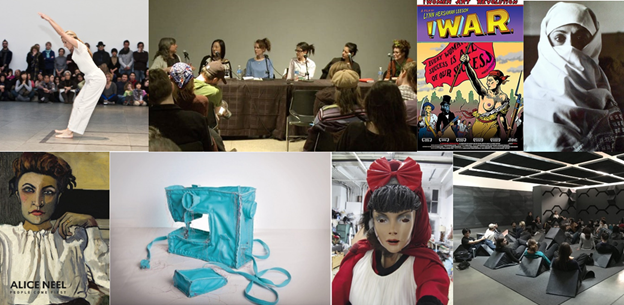
Each week this Women’s History Month, we highlight the rich scholarship and programs produced at CAA that celebrate women in the fields of visual arts and the humanities. This week, we are sharing a bibliography of articles from our open-access journal Art Journal Open that feature women artists.
This Women’s History Month is also especially significant this year, which is the 50th anniversary of feminism at CAA. To learn more about this history, visit this page. CAA is also collecting archival materials to better understand and document the history of its Committee of Women in the Arts, including the committee’s many collaborations with other affiliate committees and groups, such as the Women’s Caucus for Art, The Feminist Art Project, the Queer Caucus, and many more. Visit this page for more information.
 |
Andrew, Nell. “DadaDance: Sophie Taueber’s Visceral Abstraction.” Art Journal Open (July 3, 2014).
Sophie Taueber-Arp, Free Vertical-Horizontal Rhythms (Rythmes verticaux-horizontaux libres), 1919, gouache, 11 15⁄16 x 8 9⁄16 in. (30.3 x 21.8 cm). Stiftung Hans Arp und Sophie Taeuber Arp e.V., inv. 003.205 (artwork in the public domain; photograph provided by Stiftung Hans Arp und Sophie Taeuber Arp) |
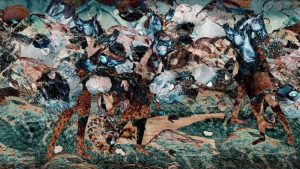 |
Barakeh, Zeina. “Projections for the Third Half [Cloud Storm].” Art Journal Open (August 6, 2020).
Zeina Barakeh, Projections From The Third Half [Cloud Storm], 2020, animation, 3 min. (artwork © Zeina Barakeh) |
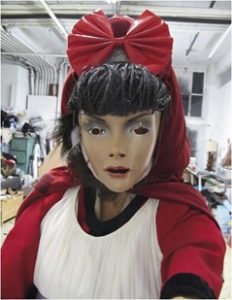 |
Barber, Tiffany E. “Narcissister, a Truly Kinky Artist.” Art Journal Open (March 11, 2020).
Narcissister, Red Riding Hood, 2014, mixed media (photograph provided by the artist) |
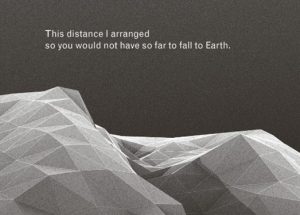 |
Berrigan, Caitlin and Sasha Engelmann. “Fault Lines and Fractures: A Conversation about Imaginary Explosions.” Art Journal Open (December 17, 2020).
Caitlin Berrigan, excerpt from Imaginary Explosions, 2018 |
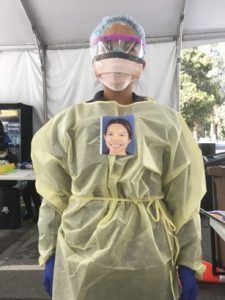 |
Bryan-Wilson, Julia and Mary Beth Heffernan. “Facing Social Practice: Mary Beth Heffernan in conversation with Julia Bryan-Wilson.” Art Journal Open (June 30, 2020).
Stanford Express Care nurse Anna Chico, who was among the first providers to use PPE Portraits for COVID-19 care, March 2020 (photograph by Cati Brown-Johnson) |
 |
Burns, A.K. and Melissa Ragain. “Scripting A Smeary Spot.” Art Journal Open (December 8, 2017).
The late Jack Doroshow performs as Mother Flawless, a clairvoyant psyche. In this scene she recites an excerpt from Joanna Russ’ sci-fi novel We Who Are About To. . . , A.K. Burns, video still from A Smeary Spot, 2015, four-channel video installation, HD color, six-channel sound, TRT 53:13 (artwork © A.K. Burns; image provided by the artist, Callicoon Fine Arts, NY, and Michel Rein Gallery, Paris/Brussels) |
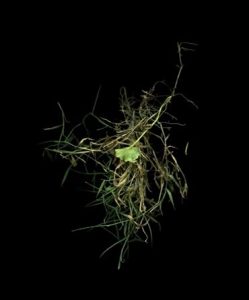 |
Cancelmo, Amy. “Roots and Ramble Kija Lucas and Amy Cancelmo in Conversation.” Art Journal Open (August 30, 2016).
Kija Lucas, Bristol 30, 2013, archival pigment print, 20 x 24 in. (50.8 x 60.9 cm), from In Search of Home, (artwork © Kija Lucas) |
 |
Carland, Tammy Rae and Ann Cvetkovich. “Sharing an Archive of Feelings: A Conversation.” Art Journal Open (October 24, 2013).
Tammy Rae Carland, Galz Living Room, MWMF, from Outpost, 2004, color photograph, 20 x 24 in. (50.8 x 61cm) (artwork © Tammy Rae Carland) |
 |
Costello, Kate. “P&P .” Art Journal Open (November 3, 2016).
Still from Kate Costello, P&P, 2016, video, 1 min., 26 sec. (artwork © Kate Costello) |
 |
Craycroft, Anna. “To Listen.” Art Journal Open (October 25, 2017).
Sophomore Seminar with Meg Cranston and Marlena Donohue, April 5, 2017: Meg Cranston and Marlena Donohue’s class met with Anna Craycroft to discuss Tuning the Room in relation to Umberto Eco’s essay “The Open Work.” (artwork © Anna Craycroft) |
 |
Craycroft, Anna. “To Record, to Interpret, to Comment.” Art Journal Open (March 1, 2017).
Anna Craycroft, The Earth Is a Magnet, 2016, installation view, part of The Artist’s Museum, Institute of Contemporary Art Boston, November 16, 2016–March 26, 2017 (artwork © Anna Craycroft; photograph by Charles Mayer) |
 |
DaPonte, Amy A. “Candida Höfer’s Turken in Deutschland as ‘Counter-publicity’.” Art Journal Open (January 6, 2017).
Candida Höfer, Untitled from Türken in Deutschland 1979, 1979, color slide projection, 80 slides, approx. 7 min., dimensions variable (artwork © Candida Höfer, Köln/VG Bild-Kunst, Bonn 2016) |
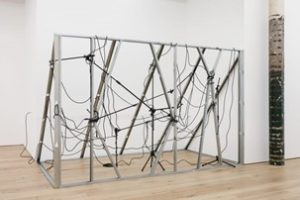 |
Fuenmayor, Jesús. “Barricades of Silence: Nikita Gale in Conversation with Jesús Fuenmayor.” Art Journal Open (August 20, 2020).
Nikita Gale, INTERCEPTOR, 2019, installation view, Fall Apart: Nikita Gale & Pat O’Neill, Martos Gallery, New York, January 11–February 24, 2019 (artwork © Nikita Gale; photograph by Charles Benton/Martos Gallery, provided by the artist) |
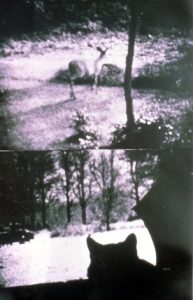 |
Goodeve, Thyrza Nichols. “The Cat is My Medium: Notes on Writing and Art of Carloee Schneemann.” Art Journal Open (July 29, 2015).
Carolee Schneemann, Kitch’s Last Meal, 1973–76, Super 8mm film, double projection, vertical, sound on cassette, ca. 5 hrs., two installation views (artwork © Carolee Schneemann; photographs provided by the artist) |
 |
Goulish, Matthew. “A Clear Day and No Memories: Neurology, Philosophy, and Analogy in Kerry Tribe’s HM.” Art Journal Open (February 5, 2014).
Eadward Muybridge, Pi-Wi-Ack, Valley of the Yosemite (Shower of Stars), “Vernal Fall,” 400 Feet Fall, No. 29, 1872, wet-plate collodion photograph (photograph in the public domain) |
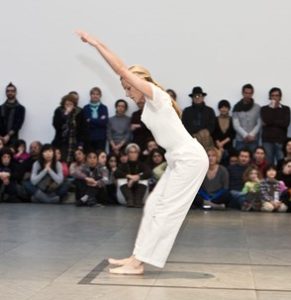 |
Graham, Amanda Jane. “Space Travels: Trisha Brown’s Locus.” Art Journal Open (July 22, 2016).
Trisha Brown, Locus Solo, 2011, performed by Diane Madden in “Performance 11: OnLine/Trisha Brown Dance Company” in conjunction with the exhibition On Line: Drawing through the Twentieth Century, Museum of Modern Art, New York, January 2011 (photographs © Yi-Chun Wu; photographs provided by Museum of Modern Art/Licensed by SCALA/Art Resource, NY) |
 |
Jenkinson, Monique. “Diva Maw.” Art Journal Open (October 29, 2020).
Monique Jenkinson (Fauxnique), Diva Maw, 2020, digital video, 5:35 min.; soundtrack by Marc Kate, Untitled (“Diva Maw” Soundtrack), 2020, audio file (video © Monique Jenkinson; soundtrack © Marc Kate) |
 |
Kauffman, Vanessa. “Outside of Time: Patricia Fernández Carcedo in Conversation with Vanessa Kauffman.” Art Journal Open (August 12, 2016).
Visitors in Patricia Fernández Carcedo’s studio during Headlands’ Fall 2015 Open House (artwork © Patricia Fernández Carcedo; photograph by Rebecca Puretz, provided by Headlands Center for the Arts) |
 |
Laser, Liz Magic and Christopher Y. Lew. “InterAct: a reenacted interview.” Art Journal Open (May 4, 2011)
Liz Magic Laser, Flight, 2010, performance, MoMA PS1, Long Island City, April 10, 2010 (artwork © Liz Magic Laser; photograph by Mia Tramz, provided by Derek Eller Gallery). The performance was developed in collaboration with actors Lindsey Andersen, Nic Grelli, Elizabeth Hodur, Michael Wiener, Max Woertendyke, and Lia Woertendyke |
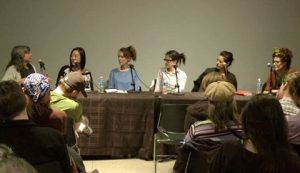 |
Lee, Young Jean. “Women in Downtown Theater.” Art Journal Open (August 26, 2012). |
 |
Leeson, Lynn Hershman. “Excerpts from the Graphic Novel !Women Art Revolution—A Secret History.” Art Journal Open (May 29, 2011) |
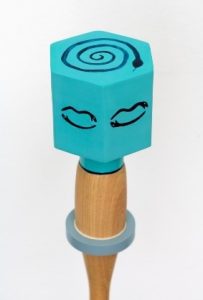 |
Mann, Elana. “One day I will make a mace, but for now I have a mouth.” Art Journal Open (September 30, 2021).
Elana Mann, Unidentified Bright Object #61, 2021, clay, wood, and glass, 14 ½ x 3 ½ x 3 ¾ in. (36.8 x 8.9 x 9.5 cm) (artwork © Elana Mann; photographs by Brica Wilcox) |
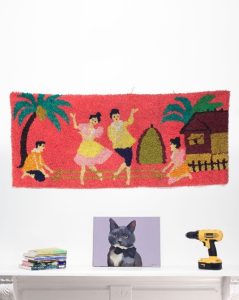 |
Masley-Charlet, Caitlin. “Caitlin Masley-Charlet in Conversation with Elisabeth Smolarz.” Art Journal Open (June 5, 2018).
Elisabeth Smolarz, ENCYCLOPEDIA OF THINGS, ongoing 2014–2017. Archival inkjet prints, dimensions variable. Courtesy of the artist. |
 |
Masley-Charlet, Caitlin. “Caitlin Masley-Charlet and Diana Shpungin in Conversation.” Art Journal Open (July 8, 2016).
Diana Shpungin, detail of A Break in One and Several Places, 2015, graphite pencil, horsehair broom, glazed porcelain and stoneware, 24 x 43 x 14 in. (60.9 x 109.2 x 35.5 cm) (artwork © Diana Shpungin) |
 |
McKee, C.C. “‘a salting of sorts’: Salt, Sea, and Affective Form in the work of Deborah Jack.” Art Journal Open (July 30, 2019).
Deborah Jack, SHORE, 2004, nylon screens, video projection, rock salt, reflecting pool, dimensions variable, installation view, Big Orbit Gallery, Buffalo, New York (artwork © Deborah Jack; photograph provided by the artist) |
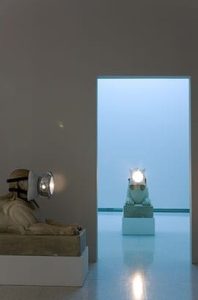 |
McClure, Michael Jay. “If it Need Be Termed Surrender: Trisha Donnelly’s Subjunctive Case.” Art Journal Open (July 29, 2013).
Trisha Donnelly, Untitled, 2008, plaster, horsehair, paint, pillow, belts, lamp, two parts, ea. 36 x 60 x 22¾ in. (91.4 x 152.4 x 57.8 cm), installation view, The Quick and the Dead, Walker Art Center, 2009 (artwork © Trisha Donnelly; photograph provided by Casey Kaplan, New York) |
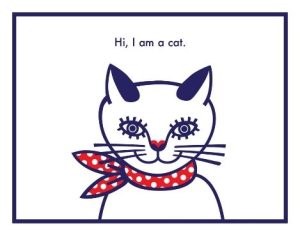 |
Ohsawa, Asuka. “Squares, Triangles, and Cats.” Art Journal Open (December 31, 2020). |
 |
Porges, Maria. “Shortest Stories.” Art Journal Open (December 20, 2018). |
 |
Rosa, María Laura. “Questions of Identity: Photographic Series by Alicia D’Amico, 1983–86.” Art Journal Open (July 2, 2019).
Alicia D’Amico photograph of Liliana, a performance by Liliana Mizrahi, 1983, scanned copy of original negative, reproduction from original 35mm negative contact (photograph © Archivo Alicia D’Amico, Buenos Aires) |
 |
Santos, Dorothy R. “ Domain Errors.” Art Journal Open (July 24, 2020). |
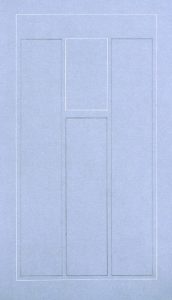 |
Schiff, Karen L. “Imprinting Agnes Martin.” Art Journal Open (December 19, 2014).
Karen L. Schiff, Agnes Martin, El País, 21 December 2004, II, 2005, graphite and stylus on vellum, 17 x 12 inches (artwork © Karen L. Schiff) |
 |
Sifuentes, Aram Han. “Official Unofficial Voting Station: Voting for All Who Legally Can’t.” Art Journal Open (October 1, 2020).
Protest Banner Lending Library, Let Us Vote! and Official Unofficial Voting Station, 2020, textile banners (photograph by Thaib A. Wahab) |
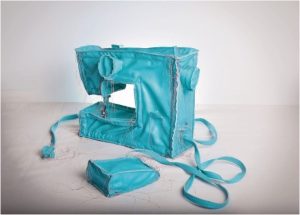 |
Szymanek, Angelique. “Haptic Encounters: Margarita Cabera’s Space in Between.” Art Journal Open (October 15, 2020).
Margarita Cabrera, Sewing Machine (Blue-Green), 2016, vinyl, thread, copper wire, and appliance parts (artwork © 2020 Margarita Cabrera/Licensed by VAGA at Artists Rights Society [ARS], NY; photograph provided by the artist) |
 |
Vlassopoulou, Penelope. “No water, Athens, Greece, 2015: Twenty-four hours with nothing to eat or drink, only smelling the jasmine.” Art Journal Open (October 26, 2016).
Excerpt from Pandelis Prevelakis, I Kefali tis Medousas [The Head of Medusa] (Athens: Friends’ Editions, 1963), trans. the artist and Markus Nystrom |
 |
Watt, Marie. “In Conversation with Marie Watt: A New Coyote Tale.” Art Journal Open (October 19, 2017).
Marie Watt, Blanket Stories: Transportation Object, Generous Ones, Trek, 2014, cast bronze, 18 x 4 x 6 ft. (5.49 x 1.22 x 1.83 m). Permanent installation, Tacoma Art Museum, Tacoma, Washington (artwork © Marie Watt; photograph by Benjamin Benschneider/OTTO) |
 |
Wilson, Siona. “Portraits (and) Matter.” Art Journal Open (January 13, 2022). |
 |
Yoshitake, Mika. “Humans have been Human for so long: Shana Lutker and Mika Yoshitake in Conversation.” Art Journal Open (August 2, 2016).
Shana Lutker, A handsome confused puppet, 2015, mirrored glass box, fluorescent lights, wood, marble, casters, 49 x 30 x 19 in. (124.4 x 76.2 x 48.2 cm) (artwork © Shana Lutker; photograph by Cathy Carver) |
 |
Yurshansky, Jenny. “Hide and Seek.” Art Journal Open (March 25, 2021).
Jenny Yurshansky, Hide and Seek (folded view), 2021, interactive sculpture, inkjet print, 3 3/4 x 3 3/4 x 3 in. (9.5 x 9.5 x 7.6 cm) (photograph provided by the artist) Folk tradition meets revisionist storytelling in Jenny Yurshansky’s printable sculpture |
Women’s History Month and caa.reviews
posted by CAA — March 04, 2022
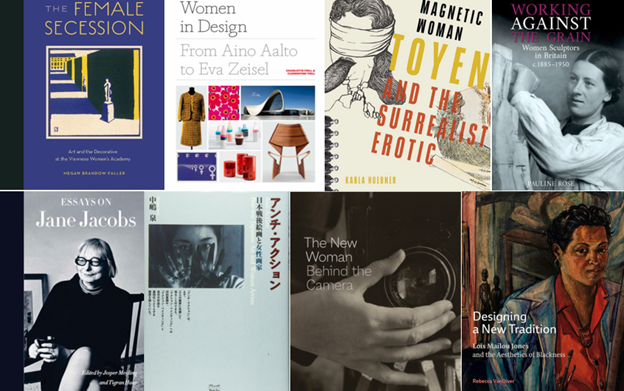
Each week this Women’s History Month, we highlight the rich scholarship and programs produced at CAA that celebrate women in the fields of visual arts and the humanities. This week, we are sharing a bibliography of publications and exhibitions reviewed this past year on our open-access journal caa.reviews that feature women artists and practitioners.
caa.reviews also houses rosters of dissertation titles in progress and completed since 2002, many of which have been written by women and focus on topics related to women and feminism in the arts.
This Women’s History Month is also especially significant this year, which is the 50th anniversary of feminism at CAA. To learn more about this history, visit this page. CAA is also collecting archival materials to better understand and document the history of its Committee of Women in the Arts, including the committee’s many collaborations with other affiliate committees and groups, such as the Women’s Caucus for Art, The Feminist Art Project, the Queer Caucus, and many more. Visit this page for more information.
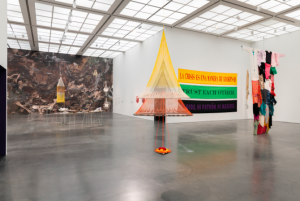 |
Acevedo-Yates, Carla, editor. Carolina Caycedo: From the Bottom of the River. Chicago and New York: Museum of Contemporary Art Chicago and DelMonico Books/D.A.P., 2020.
Carolina Caycedo: From the Bottom of the River, installation view, Museum of Contemporary Art Chicago, 2020–21 (photograph by Nathan Keay, © MCA Chicago) |
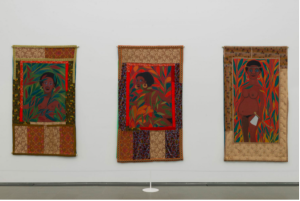 |
Blanchflower, Melissa, Natalia Grabowska, and Melissa Larner, editors. Faith Ringgold. Serpentine Gallery, London, United Kingdom. Cologne: Walther König, 2019.
Faith Ringgold, Slave Rape, 1972, installation view, Faith Ringgold, Serpentine Gallery, London, 2019 (artwork © 2019 Faith Ringgold; photograph provided by readsreads.info) |
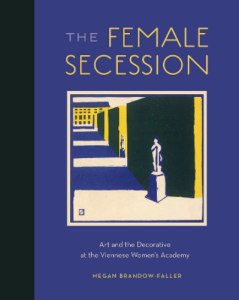 |
Brandow-Faller, Megan. The Female Secession: Art and the Decorative at the Viennese Women’s Academy. University Park, PA: Penn State University Press, 2020. |
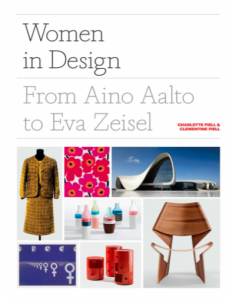 |
Fiell, Charlotte and Clementine Fiell. Women in Design: From Aino Aalto to Eva Ziesel. London: Laurence King Publishing, 2019. |
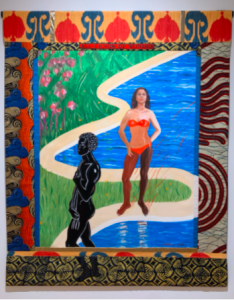 |
Harris, Shawnya L. editor. Emma Amos: Color Odyssey. Athens: Georgia Museum of Art, University of Georgia, 2021.
Emma Amos, All I Know of Wonder, 2008, oil on linen, African fabric, 70 1/2 x 55 1/2 in. (179.1 x 141 cm), installation view, Emma Amos: Color Odyssey, Georgia Museum of Art, University of Georgia, Athens, 2021 (photograph by the author) |
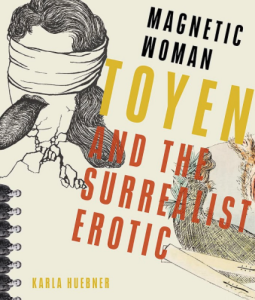 |
Huebner, Karla. Magnetic Woman: Toyen and the Surrealist Erotic. Pittsburgh, PA: University of Pittsburgh Press, 2020. |
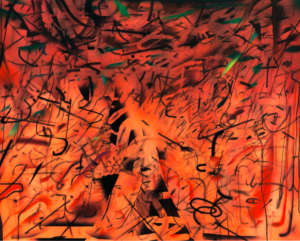 |
Kim, Christine Y. and Rujeko Hockley. Julie Mehretu. New York: Whitney Museum of American Art in association with Prestel, 2019.
Julie Mehretu, Hineni (E. 3:4), 2018, ink and acrylic on canvas, 96 × 120 in. (243.8 x 304.8 cm). Centre Pompidou, Paris, Musée national d’art moderne/Centre de création industrielle, gift of George Economou, 2019 (artwork © Julie Mehretu; photograph by Tom Powel Imaging) |
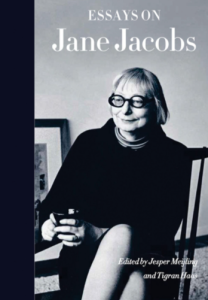 |
Meijling, Jesper and Tigran Haas, editors. Essays on Jane Jacobs. Stockholm: Bokförlaget Stolpe, 2020. |
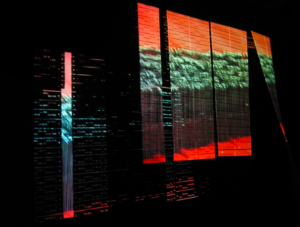 |
Mühling, Matthias and Stephanie Weber, editors. Senga Nengudi: Topologies. Munich: Hirmer, 2021.
Senga Nengudi, Warp Trance, 2007, multi-channel audio/video installation in collaboration with the Fabric Workshop and Museum, Philadelphia, with a sound composition by Butch Morris, installation view, Senga Nengudi: Topologies, Philadelphia Museum of Art, 2021 (photograph © Aaron Igler, provided by the artist and The Fabric Workshop and Museum) |
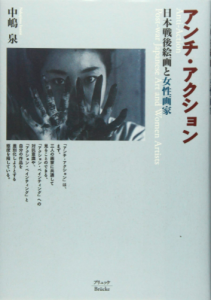 |
Nakajima, Izumi. Anti-Action: Post-War Japanese Art and Women Artists (アンチ・アクション: 日本戦後絵画と女性画家). Tokyo: Brücke, 2019. |
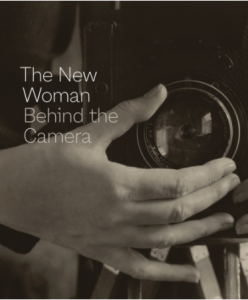 |
Nelson, Andrea editor. The New Woman behind the Camera. Washington, DC: National Gallery of Art, 2020. |
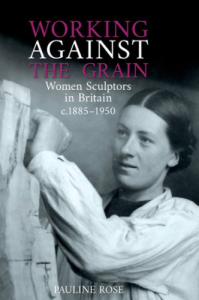 |
Rose, Pauline. Working against the Grain: Women Sculptors in Britain c.1885–1950. Liverpool, UK: Liverpool University Press, 2020. |
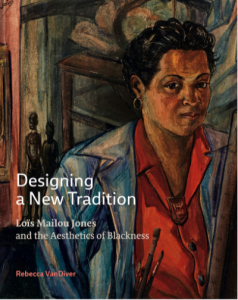 |
VanDiver, Rebecca. Designing a New Tradition: Loïs Mailou Jones and the Aesthetics of Blackness. University Park, PA: Penn State University Press, 2020. |
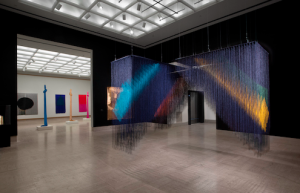 |
Walker, Anna and Laura Mott, editors. Olga de Amaral: To Weave a Rock. Arnoldsche Art Publishers in association with the Museum of Fine Arts, Houston, 2020.
Olga de Amaral, Brumas, 2013, acrylic, gesso, and cotton on wood, installation view, Olga de Amaral: To Weave a Rock, Cranbrook Art Museum, October 30, 2021–March 20, 2022 (artwork © Olga de Amaral; photograph by P. D. Rearick, image provided by Cranbrook Art Museum) |
CAA’s Committee on Women in the Arts: Call for Archival Materials
posted by CAA — January 14, 2022

Button design celebrating 50% representation of women at the 2020 Conference, designed by the Committee on Women in the Arts (CWA).
Help CAA celebrate its 50th anniversary of feminism at the organization! CAA wants to better understand and document the history of its Committee of Women in the Arts, including the committee’s many collaborations with other affiliate committees and groups, such as the Women’s Caucus for Art, The Feminist Art Project, the Queer Caucus, and many more. To this end, CAA is issuing a call to expand its CWA archives through a crowd sourcing campaign.
If you ever served on the CWA or collaborated with its members, please consider contributing images of photographs or ephemera, memories that are pertinent to its history, or any digital files or recordings. Any contributions will become eligible to become part of CAA institutional archive and will be featured in a series of CAA social media posts reflecting on our history and shared throughout 2022. It is imperative that CAA digitizes these important resources to ensure that the history of women’s contributions to the arts and arts education are not forgotten
To submit:
- Send materials and questions to info@collegeart.org, with “CAA Feminism” in the subject line
- Provide:
- Name and email
- Social media handles or accounts (if you would like us to tag you in the post)
- Date of material / date of acquisition
- Description of material/ contents
- Preferred credit line (I.e.: image/material provided to CAA courtesy of XXX / anonymous)
- Permissions: Copy and paste this sentence into your email if you would allow us to feature the image on social media: “I give permission to share this material on social media.”
- Donations: If you would like to donate the original materials to CAA, please copy and paste this sentence into your email: “I would like to donate these materials to CAA.”
- Attachment of the material, following these specs:
- Image/document: please send jpegs that are at least 1200 px on the longest side, 72 ppi
- Audio: MP3 format
- Video: MP4 or mov


